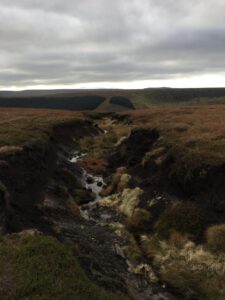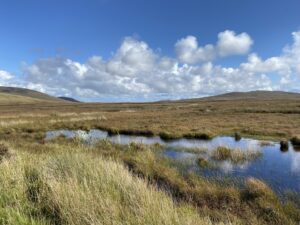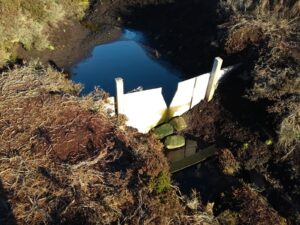PEAT-POOLS: Carbon and nutrient cycling in peatland pools

Peatland restoration is increasingly used as a nature-based solution to climate change, as the UK and other countries work towards net-zero targets. Intact peatlands are naturally water-logged, slowing decomposition and accumulating carbon-rich organic matter, while drained, damaged and degraded peatlands emit greenhouse gases (GHGs). When restored, they can provide ecosystem services such as carbon sequestration and storage, enhance biodiversity, nutrient and contaminant filtration, and water storage.
 Peatland surface waters, including naturally occurring open water pools and headwater streams, are an important interface where carbon-rich peat meets an aquatic system, resulting in water with high dissolved and particulate aquatic carbon concentrations. These waters are important in biogeochemical cycling, but there are still major uncertainties related to how they process carbon and how this processing impacts local ecosystem metabolism and carbon budgets.
Peatland surface waters, including naturally occurring open water pools and headwater streams, are an important interface where carbon-rich peat meets an aquatic system, resulting in water with high dissolved and particulate aquatic carbon concentrations. These waters are important in biogeochemical cycling, but there are still major uncertainties related to how they process carbon and how this processing impacts local ecosystem metabolism and carbon budgets.
Natural pools vary in size and depth, with variable vegetation cover, light penetration and temperature regimes. Some pools connect with headwater streams, whereas some are disconnected from the river network. Without knowing how the ecosystem functions, we cannot predict the impact of changing climate and hydrology on carbon processing and GHG emissions from these pools. The area of peatland covered in open water pools is increasing, as climate change melts permafrost, and studies have shown peatland pools can cover up to 70% of a total peatland area. These ecosystems are likely to be significant hotspots of carbon turnover and GHG emissions, but they are rarely included in peatland GHG budgets.

Peatland restoration strategies often include creating artificial open water pools, by blocking drains/gullies or ‘smoothing’ the peatland surface. These ‘restoration pools’ physically affect the peat, by exposing previously buried peat to water and air, and by disturbing the surface, creating new pathways for water within the peat. This fundamentally alters biogeochemical cycling within peatland systems by modifying carbon transport pathways (e.g. via surface water, leaching through groundwater, or changing storage times), and transformations, both biotic (respiration and photosynthesis) and abiotic (photo-oxidation). The ‘freshly’ exposed peat could be more reactive than surface peat, and lead to higher rates of carbon loss. Surface disturbance could cause an increase in available nutrients into the previously nutrient-poor pool water, leading to faster metabolism of carbon and nitrogen. There is very little research on the impact of this influx of nutrients on the fluxes of not only CO2, but also CH4 and N2O.

Restoration pools tend to be more consistent in size than natural pools (e.g. as they are formed by blocking a drainage ditch with a digger shovel) and so represent an ideal environment to study the impact of pool size (area and depth) on carbon processing, while contributing important knowledge to the carbon budget of peatlands. Comparing restoration pools with natural pools will also show if there is a relationship between restoration state, pool size and carbon emissions, which could in turn impact on future restoration strategies.
This project will include field measurements of GHGs (CO2, CH4 and N2O) from pools of different restoration states and different sizes, analysis of water chemistry (aquatic carbon, dissolved nutrients etc.), and manipulation experiments on nutrient concentrations in pool water, that will ground-truth a model of GHG emissions from peatland pools. This project has the potential to study peatlands from molecular and microbial, up to full ecosystem scales. It can encompass field work, lab experiments and computer models, working with strengths and interests of the candidate.
This project fits within several of NERCs research areas, including atmospheric physics and chemistry, climate change, and terrestrial and freshwater environments. It will also align with two ongoing NERC Independent Research Fellowship projects at the University of Leeds.
